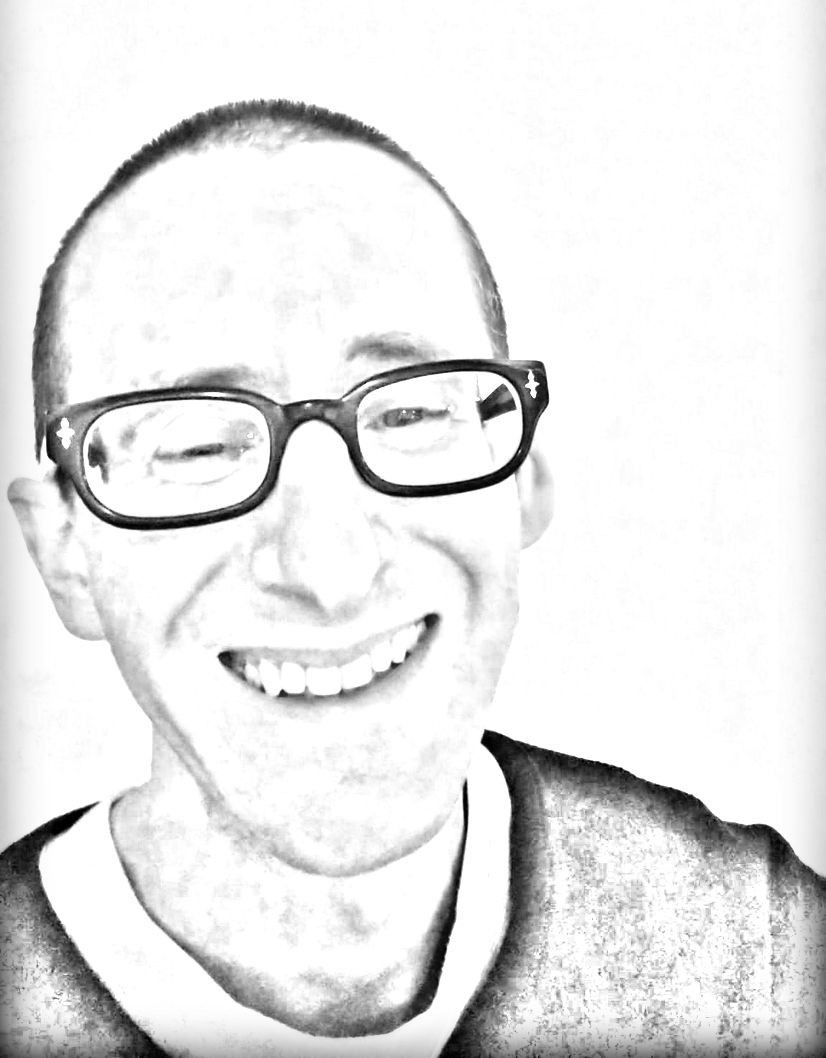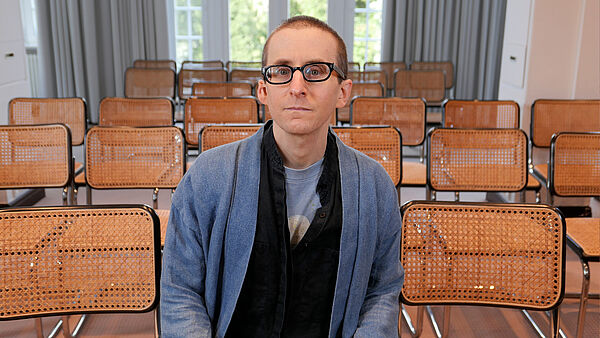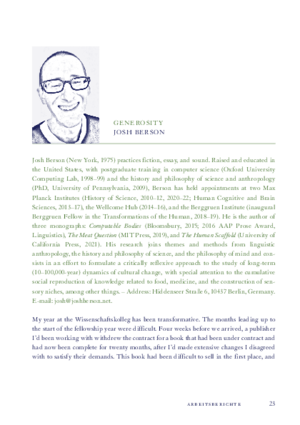
Joshua Berson, Ph.D.
Anthropologist, Philosopher
Berlin
Born in 1975 in New York City, N.Y., USA
Studied Design of the Built Environment at Harvard University and Anthropology and History and Philosophy of Science at the University of Pennsylvania
Arbeitsvorhaben
The Habit of Life
What began as a study of the cognitive ecology of animacy – how our habits of classifying the world into animate and inanimate are shaped by our strategies for keeping body and soul intact – has grown into something at once more expansive and more personal.In The Habit of Life, I offer an exploratory account of what it is to experience another presence as a “familiar”– and what kind of ethos, what kind of “habit of life,” takes form when we attend to the role of the senses in mediating this experience.
Starting with my own experience as a monaural hearer, I formulate an ecology of the senses that emphasizes the resonant properties of the Earth and our bodies and the role that sound and other field phenomena play in bringing us into contact with other presences living and geospheric. In contrast, say, to vision, for the mechanosensory (acoustic, tactile, proprioceptive, interoceptive) senses, we are rarely in a position to blockade or orient the organs of sensation. In our encounters with the mechanosensory world, we are confronted with our permeability, not to say our impermanence. Recovering an awareness of our impermanence, I propose, is the key to formulating a habit of life that resists the urge to view our situation as one of permanent crisis.
The Habit of Life draws together strategies of inference from cognitive and linguistic anthropology and the philosophy of the evolutionary sciences. It represents the culmination of a ten-year effort to formulate a critical approach to the study of niche construction – a way of reasoning about our strategies for accommodating bodily need that attends to how these strategies become saturated with value.
Recommended Reading
Berson, Josh. The Meat Question. Cambridge, MA: MIT Press, 2019.
—. The Human Scaffold. Oakland: University of California Press, 2021.
Kolloquium, 17.10.2023
Hülle
Die Idee zu diesem Buch kam mir während eines künstlerischen Aufenthalts in Onishi, Präfektur Gunma im September 2017. Der Monsun war spät gekommen, und die Hitze und die Luftfeuchtigkeit sprachen gegen Anstrengungen jedweder Art. Ich verbrachte die meiste Zeit damit, auf dem Boden meines Zimmers zu liegen, und versuchte, den Schlaf aufzuholen, der mir in der Nacht zuvor entgangen war. Spätnachmittags ging ich um die Ecke in mein Studio und hörte mir die algorithmischen Wiederholungen einer Tonaufnahme an, die ich in der Grundschule vor Ort gemacht hatte. Ich hatte die Aufnahme in sich überlappende Halbsekundensegmente aufgeteilt, die ich anhand ihrer spektralen Eigenschaften neu sequenzierte und dann zu etwas Neuem zusammenfügte. Das Ergebnis war repetitiv, durchsetzt mit dem Geräusch der Schulklingel, die teilweise durch die Aufnahme hindurchklang. Für mich klang das wie das Zirpen der Laubheuschrecken, die die ganze Nacht im Gras sangen. Es schien, als sei ich vom Zeitstrahl meines gewöhnlichen Lebens in einen Wachtraum drückender Hitze getreten.
Wenn man mich um eine Beschreibung dessen bäte, worum es in diesem Buch geht, was sein Thema ist, würde ich vielleicht sagen: die sinnliche Ökologie von Klang und dessen Bedeutung für das Verständnis von Lebendigkeit.
Man könnte sagen: Darum geht es in diesem Buch, und zwar in dem Sinne, dass das etwas ist, das ich im Kopf hatte, als ich daran gearbeitet habe. Aber es gibt noch ein zweites Thema ("aboutness"), das mit geschaffenen Dingen verbunden ist – das Thema des Prozesses. Wenn man mich um eine Beschreibung dessen bitten würde, worum es in diesem Buch in diesem zweiten Sinne geht, würde ich vielleicht sagen:
Das Zurückschneiden von Bindegewebe.
Eindeutige Argumente abbauen.
Sich erlauben, auf metadiskursive Formulierungen der Art „worum es in diesem Buch geht“ zu verzichten.
Dem Drang nachgeben, absichtslos zu sein.
Die eigenen Abwehrmechanismen abschaben.
Ein erfreulicheres Bild: Schaben als Akt der Gestaltung—wie die Tasmanier des späten Pleistozäns, die die Innenseite von Wallaby-Fellen mit facettierten Steinwerkzeugen schabten, um sie als Kleidung tragbar zu machen (siehe Berson, "The Human Scaffold", Kap. 2).
Oder: Schaben wie in "gua sha", dem Hervorrufen von Einblutungen in der Haut. Etwas zum Blühen in der Haut anregen.
Publikationen aus der Fellowbibliothek
Berson, Joshua (Berkeley, CA, 2021)
The Human Scaffold : How Not to Design Your Way Out of a Climate Crisis Great Transformations ; 2
Berson, Joshua (Oakland, California, 2021)
The human scaffold : how not to design your way out of a climate crisis Great transformations ; 2
Berson, Joshua (Cambridge, 2019)
The meat question : animals, humans, and the deep history of food
Berson, Joshua (Cambridge, Massachusetts, 2019)
The meat question : animals, humans, and the deep history of food

